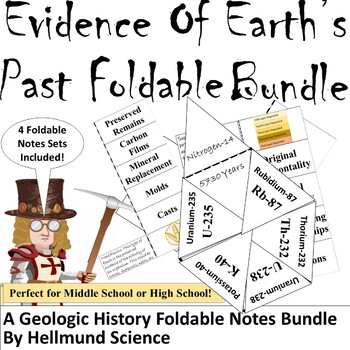Evidence of Earth's Past Foldable Notes Bundle
- Zip
Products in this Bundle (4)
Description
Review the evidence for Earth's history with this Evidence of Earth's Past foldable notes bundle! Students can have trouble explaining how fossils are created and dated, but this bundle of foldable notes will allow them to define the different types of fossils and provide a helpful set of examples for how scientists discover the ages of rock and fossils. Your class will then display improvement when it comes to describing how Earth's history is uncovered. These notes come with easy to follow instructions and a key defining each of portion of the foldable so that you can maximize the effectiveness with your students.
Purchasing this bundle will save you from spending more money on buying each foldable separately! Buy 3 get 1 Free!
Within this bundle you get 4 sets of foldable notes covering the following topics:
Radioactive Isotopes for Dating Foldable
Students will be able to demonstrate skills related to these learning targets:
- I can explain the differences between the six different types of fossils.
- I can explain the five principles of relative dating.
- I can explain different methods for how scientists use absolute dating to learn about the age of rock layers and fossils.
Essential Vocabulary within this lesson:
Fossils, Preserved Remains, Carbon Films, Mineral Replacement, Molds, Casts, Trace Fossils, Relative Dating, Principle, Superposition, Original Horizontality, Lateral Continuity, Inclusions, Intrusions, Cross-Cutting Relationships, Uniformitarianism, Geologic Record, Absolute Dating, Isotope, Radioactive Decay, Daughter Isotope.
Within this download you will get the student foldable handout which is formatted for easy student use, instructions, and a key defining each unit of geologic time!
Combine this activity with the Quest- The Time Machine, Quest- The Principles of Relative Dating, or Quest- What Did It Look Like? for a greater impact!
This activity can be easily assigned for "distance-learning" or "at-home learning." Just provide students with access to the necessary reference information!
Need an emergency sub plan handy for a quick review? Use this activity as a low-prep option!
Copyright © 2023 Daniel Hellmund, Hellmund Science
All rights reserved by author.
Permission to copy for classroom use only.
Electronic distribution limited to classroom use only.
Don't forget to follow us by clicking the little green star under our store name!
Leaving feedback grants you TPT credits for future purchases!
Hellmund Science offers a variety of gamified science labs, notes, projects and games with Universal Design for Learning (UDL) and Project-Based Learning in mind. Gamification allows for Positive Behavioral Intervention Support as well as differentiation. Using this format, students learn to work together and choose the path of their liking to learn various learning targets. Your students will play to learn!


